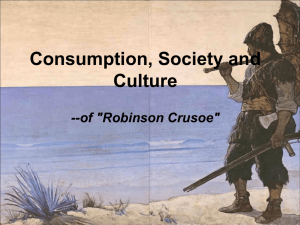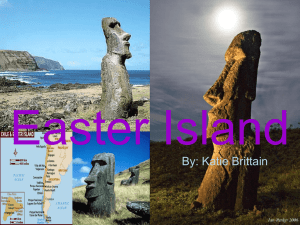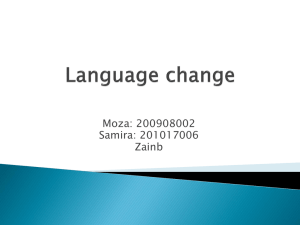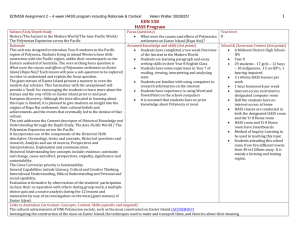Easter Island
advertisement
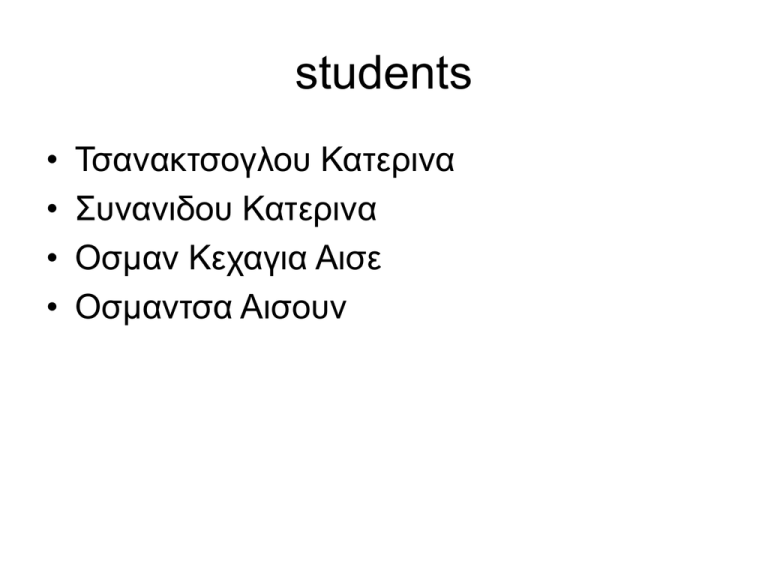
students • • • • Τσανακτσογλου Κατερινα Συνανιδου Κατερινα Οσμαν Κεχαγια Αισε Οσμαντσα Αισουν Summary Easter Island is a Polynesian island in the southeastern Pacific Ocean, at the southeastern most point of the Polynesian triangle. A special territory of Chile that was annexed in 1888, Easter Island is famous for its 887 extant monumental statues, called moai, created by the early Rapanui people. It is a World Heritage Site with much of the island protected within Rapa Nui National Park. In recent times the island has served as a warning of the cultural and environmental dangers of overexploitation. Ethnographers and archaeologists also blame diseases carried by European colonizers and slave raiding of the 1860s for devastating the local peoples. Easter Island is claimed to be the most remote inhabited island in the world. Name • The name "Easter Island" was given by the island's first recorded European visitor, the Dutch explorer Jacob Roggeveen, who encountered it on Easter Sunday 1722, while searching for Davis or David's island. Roggeveen named it Paasch-Eyland the Island’s official Spanish name, Isla de Pascua, also means "Easter Island». The current Polynesian name of the island, Rapa Nui, "Big Rapa", was coined after the slave raids of the early 1860s, and refers to the island's topographic resemblance to the island of Rapa in the Bass Islands of the Austral Islands group. He was unable to elicit a Polynesian name for the island itself, and concluded that there may not have been one. According to Barthel (1974), oral tradition has it that the island was first named Te pito o Te kainga a Hau Maka "The little piece of land of Hau Maka". Another name, Mata ki Te rangi, means "Eyes looking to the sky". Location and physical geography • Easter Island is one of the world's most isolated inhabited islands. Its closest inhabited neighbor is Pitcairn Island, 2,075 km (1,289 mi) to the west, with fewer than 100 inhabitants. Easter Island's latitude is close to that of Caldera, Chile, and it lies 3,510 km (2,180 mi) west of continental Chile at its nearest point (between Lota and Lebu). Isla Salas y Gomez, 415 km (258 mi) to the east, is closer but is uninhabited. • The island is about 24.6 km (15.3 mi) long by 12.3 km (7.6 mi) at its widest point; its overall shape is triangular. It has an area of 163.6 square kilometers (63.2 sq mi), and a maximum altitude of 507 meters (1,663 ft). There are three Rano (freshwater crater lakes), at Rano Kau, Rano Raraku and Rano Aroi, near the summit of Terevaka, but no permanent streams or rivers. Language • The first inhabitants were Polynesians and reached it with rafts in the 5th century. The language Rapa Nui is one of the estimated 1000-1200 Afstronisiakes languages, as differentiation criteria between language and dialect. The largest population of the island comes from a subgroup of Polynesian islands of the group Marquesas (märkā `säs). The original vocabulary of Rapa Nui language has been lost except for some mixed Polynesian and non-words were recorded before the introduction of taitinis dialect by missionaries in the decimated population of 1864. Today in general and Spanish. History • The history of Easter Island is rich and controversial. Its inhabitants have endured famines, epidemics, civil war, slave raids, colonialism, and near deforestation; its population declined precipitously more than once. Estimated dates of initial settlement of Easter Island have ranged from 300 to 1200 CE, approximately coinciding with the arrival of the first settlers in Hawaii. Rectifications in radiocarbon dating have changed almost all of the previously-posited early settlement dates in Polynesia. According to oral tradition, the first settlement was at Anakena. Jared Diamond notes that the Caleta Anakena landing point provides the best shelter from prevailing swells, as well as a sandy beach for canoe landings and launchings, so it seems likely to have been an early place of settlement. However, this hypothesis contradicts radiocarbon dating, according to which other sites preceded Anakena by many years, especially the Tahai, whose radiocarbon dates precede Anakena's by several centuries. The island was most likely populated by Polynesians who navigated in canoes or catamarans from the Gambier Islands or the Marquesas Islands, 3,200 km away • When James Cook visited the island, one of his crew members, a Polynesian from Bora Bora, was able to communicate with the Rapa Nui. The language most similar to Rapa Nui is Mangarevan with an 80% similarity in vocabulary. In 1999, a voyage with reconstructed Polynesian boats was able to reach Easter Island from Mangareva in 19 days. The high chief was the eldest descendent through first-born lines of the island's legendary founder, Hotu Matu'a. The most visible element in the culture was the production of massive statues called moai that represented deified ancestors. It was believed that the living had a symbiotic relationship with the dead where the dead provided everything that the living needed (health, fertility of land and animals, fortune etc.) and the living through offerings provided the dead with a better place in the spirit world. Most settlements were located on the coast and moai were erected along the coastline, watching over their descendants in the settlements before them, with their backs toward the spirit world in the sea. Culture • • • • • • • • • • Mythology Stone work Moai (statues) Ahu Stone walls Stone houses Petroglyphs Caves Rongorongo Wood carving Moai • The large stone statues, or moai, for which Easter Island is world-famous, were carved from 1100–1680 CE (rectified radio-carbon dates). A total of 887 monolithic stone statues have been inventoried on the island and in museum collections so far. Although often identified as "Easter Island heads", the statues are actually torsos, with most of them ending at the top of the thighs, although a small number of them are complete, with the figures kneeling on bent knees with their hands over their stomachs. Some upright moai have become buried up to their necks by shifting soils. Almost all (95%) moai were carved out of distinctive, compressed, easily worked solidified volcanic ash or tuff found at a single site inside the extinct volcano Rano Raraku. The native islanders who carved them used only stone hand chisels, mainly basalt toki, which lie in place all over the quarry. The stone chisels were sharpened by chipping off a new edge when dulled. The volcanic stone was first wetted to soften it before sculpting began, then again periodically during the process. While many teams worked on different statues at the same time, a single moai took a team of five or six men approximately one year to complete. Each statue represented the deceased head of a lineage. Only a quarter of the statues were installed, while nearly half remained in the quarry at Rano Raraku and the rest sat elsewhere, probably on their way to final locations. The largest moai ever raised on a platform is known as "Paro". It weighs 82 tons and 9.8 m (32.15 ft) long. In 2011, a large Moai statue was excavated from the ground, suggesting that the statues are much older and larger than previously thought. • Ahu Ahu are stone platforms. Varying greatly in layout, many were reworked during or after the huri mo'ai or statue–toppling era; many became ossuaries; one was dynamited open; and Ahu Tongariki was swept inland by a tsunami. Of the 313 known ahu, 125 carried moai—usually just one, probably because of the shortness of the moai period and transportation difficulties. Ahu Tongariki, one kilometer from Rano Raraku, had the most and tallest moai, 15 in total. Other notable ahu with moai are Ahu Akivi, restored in 1960 by William Mulloy, Nau Nau at Anakena and Tahai. Some moai may have been made from wood and were lost. The classic elements of ahu design are: • A retaining rear wall several feet high, usually facing the sea • A front wall made of rectangular basalt slabs called paenga • A facia made of red scoria that went over the front wall (platforms built after 1300) • A sloping ramp in the inland part of the platform, extending outward like wings • A pavement of even–sized, round water–worn stones called poro • An alignment of stones before the ramp • A paved plaza before the ahu. This was called marae • Inside the ahu was a fill of rubble. • Petroglyphs Petroglyphs are pictures carved into rock, and Easter Island has one of the richest collections in all Polynesia. Around 1,000 sites with more than 4,000 petroglyphs are catalogued. Designs and images were carved out of rock for a variety of reasons: to create totems, to mark territory or to memorialize a person or event. There are distinct variations around the island in terms of the frequency of particular themes among petroglyphs, with a concentration of Birdmen at Orongo. Other subjects include seaturtles, Komari (vulvas) and Makemake, the chief god of the Tangat manu or Birdman cult. Petroglyphs are also common in the Marquesas islands.





